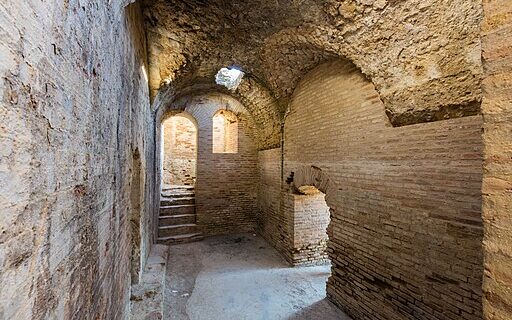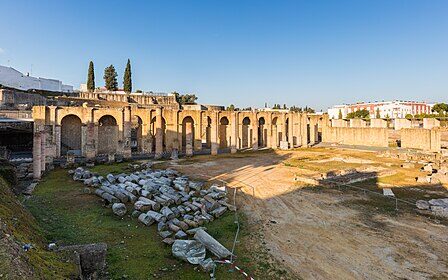Seville Itineraries
Top Attractions
- Royal Alcazar
- Seville Cathedral
- Metropol Parasol (Las Setas)
- Seville Bullring
- Plaza de Espana
- Casa de Pilatos
- Flamenco Show
- Maria Luisa Park
- Archivo de Indias
- Torre del Oro
- Seville Tiles (Azulejos)
- Bullfighting
- Football Stadium Tour
- Opera House
- Museum of Illusions
- Seville Aquarium
- Isla Mágica
- Jardines de Murillo
Disclaimer
Posts on visit-seville.com may contain affiliate links, meaning we get a small commission if you decide to make a purchase through our links, at no cost to you. Any income earned helps maintain this website and keeps it ad-free.
Italica Seville – Roman Ruins Sevilla Guide and Tickets
Italica Seville – Roman Ruins Sevilla Guide and Tickets
Visitor Information for Seville Roman Ruins Italica


Italica, located just outside of Seville, is an ancient Roman city that boasts well-preserved ruins and offers a captivating glimpse into Roman civilisation.
Visitors can explore the expansive ruins, including an impressive amphitheater—one of the largest in the Roman Empire—where gladiator contests once took place. The archaeological site provides a fascinating journey back in time, allowing visitors to wander through ancient streets, and marvel at the historic Roman architecture.
Italica Seville General Information |
|
Location | Av. Extremadura, 2, 41970 Santiponce, Sevilla, Spain |
Opening Times | Monday to Saturday: 10:45AM – 5PM, |
Entry and Tickets | Italica Seville Roman Ruins entry starts at €16 including skip-the line and a guided tour (Book Tickets Online). |
Italica Sevilla Tickets and Tours |
How to buy tickets to Italica Seville Roman RuinsTickets to Italica Roman Ruins Seville start from €16, including skip the line access as well as a guided tour in a variety of available languages. Book Standard Ticket:Seville Travel Ticket: |
Overview and History of Italica Seville
Founded in 206 BCE by the Roman general Publius Cornelius Scipio Africanus, Italica holds a rich historical background. Initially established as a settlement for Roman soldiers wounded in the Second Punic War, it soon evolved into a flourishing city. With prominent residents like the Roman emperors Trajan and Hadrian hailing from Italica, the city gained prestige.
Over time, Italica faced the challenges of shifting political landscapes and the gradual decline of the Roman Empire. The once-bustling streets witnessed a dwindling population, eventually succumbing to abandonment.
Its most iconic feature, the amphitheater, built during the 1st century AD, once hosted gladiator contests and other public spectacles. The city continued to prosper until the decline of the Roman Empire, after which it fell into obscurity. Rediscovered and excavated in the 18th century, the archaeological site showcases well-preserved ruins, offering a glimpse into Italica’s glorious past and its contributions to the Roman world.
What to See in Italica Seville
When visiting Italica near Seville, be sure not to miss the iconic Roman amphitheater. This well-preserved structure once hosted gladiatorial contests and seated thousands, offering a glimpse into the spectacles of ancient Roman entertainment. The amphitheater’s grandstand and intricate architectural details are a must-see.
Explore the city’s ruins to discover the impressive mosaics that adorned Roman homes, providing insights into daily life. The House of the Planetarium, known for its celestial-themed mosaic, is particularly captivating. Additionally, the Traianeum, dedicated to Emperor Trajan, showcases the city’s connection to Roman imperial rule.
Don’t forget to stroll through the Decumanus Maximus, Italica’s main thoroughfare, lined with remnants of public buildings and private residences. Finally, make time for the onsite museum, which houses artefacts and further enriches the historical experience of Italica.
Italica Location and how to get there from Seville
Italica is conveniently located just outside Seville, making it an accessible day trip. Situated in the town of Santiponce, approximately 9 kilometers northwest of Seville, Italica is easily reachable by various modes of transportation.
By Car:
- Take the A-66 highway heading north from Seville.
- Follow signs to Santiponce and Italica. The journey takes around 15-20 minutes.
By Public Transport:
- From Seville’s city center, take bus C1 or C3 towards Santiponce.
- The bus ride typically takes around 30 minutes.
- Disembark at the Italica entrance or in Santiponce, and it’s a short walk to the archaeological site.
By Guided Tours:
- Joining a guided tour is a convenient option, with many tours departing from Seville.
- Tours often include transportation, entry tickets, and informative guides.


